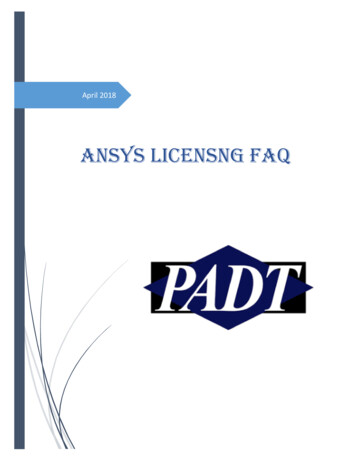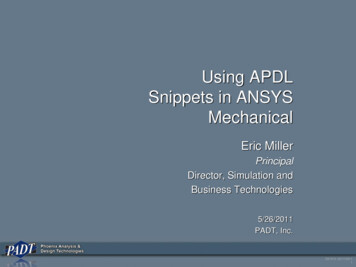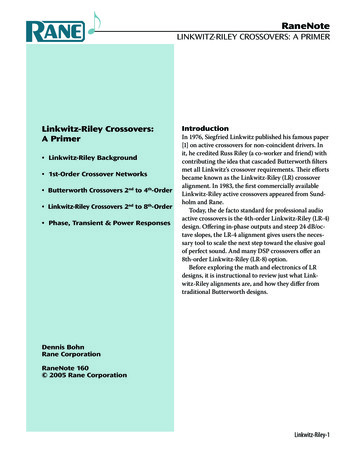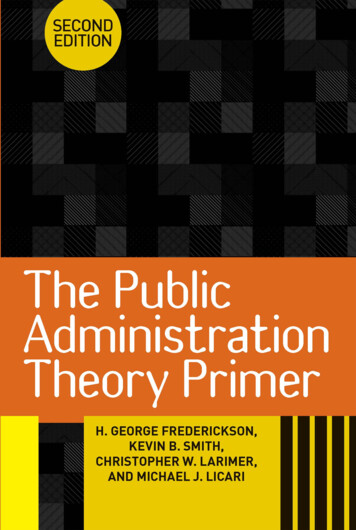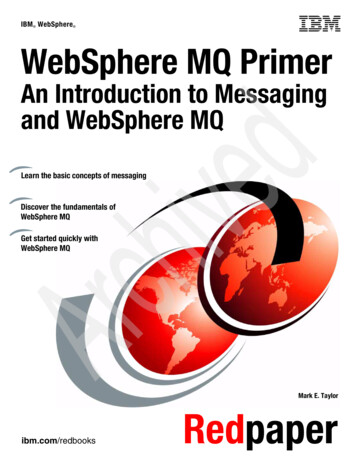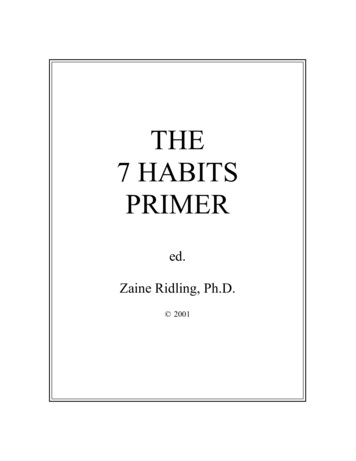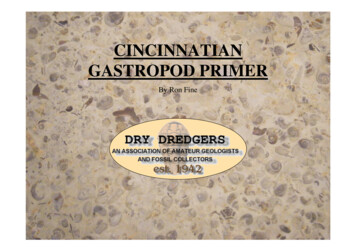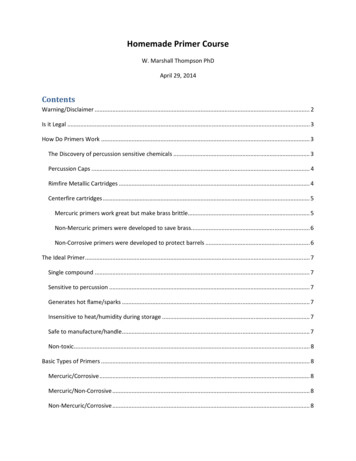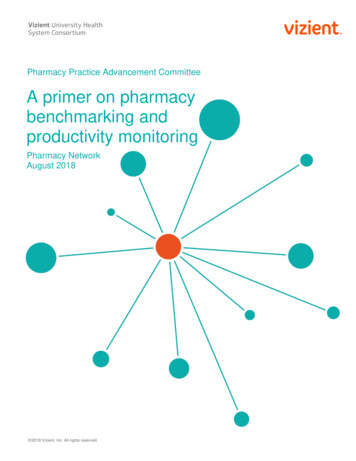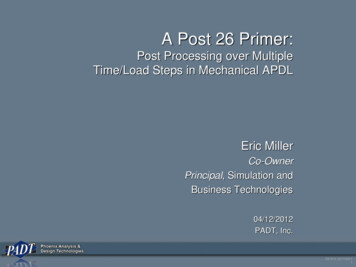
Transcription
A Post 26 Primer:Post Processing over MultipleTime/Load Steps in Mechanical APDLEric MillerCo-OwnerPrincipal, Simulation andBusiness Technologies04/12/2012PADT, Inc.DX R13: 02/17/20111
Agenda Note: This presentation is beingrecorded IntroductionsFundamentalsDefining VariablesViewing VariablesCalculatingOther POST26 ToolsSuggestions andRecommendationsDX R13: 02/17/20112
IntroductionsDX R13: 02/17/20113
Upcoming Webinars Upcoming Webinars––––––––– Feb 9, 2012 - 12:00 MSTWorking Directly with Nodes and Elements in ANSYS MechanicalFeb 23, 2012 - 12:00 MSTAssembly Meshing in ANSYS R14 CANCELEDMarch 8, 2012 - 12:00 MSTIntro to Workbench Framework Scripting - Controlling projects, materials, and solution execution with pythonMarch 22, 2012 - 12:00 MSTMastering the Remote Solver Manager (RSM) at R14April 12, 2012 – 12:00 MSTA POST26 Primer: Post Processing over Multiple Time/Load Steps in Mechanical APDLApril 26, 2012 – 12:00 MSTA Constraint Equation Primer: How to Tie Degrees of Freedom TogetherMay 10, 2012 – 12:00 MSTOptimization with ANSYS DesignXplorer at R14May 24, 2012 – 12:00 MSTModeling Moisture Diffusion in ANSYSSummer Break: June & July (maybe August)Primers are new:– Oriented towards newer users or Workbench users who may not have experience withsome of the fundamentals in the ANSYS Mechanical APDL solver See upcoming and past webinars at:– padtincevents.webex.com Click on ANSYS Webinar SeriesDX R13: 02/17/20114
About PADT PADT is an Engineering ServicesCompany– Mechanical Engineering– 18 Years of Growth and Happy customers– 70’ish Employees 3 Business Areas– CAE Sales & Services Consulting, Training, Sales, Support– Product Development– Rapid Prototyping & Manufacturing Learn More: www.PADTINC.comWe Make Innovation WorkDX R13: 02/17/20115
Cube HVPC Systems Balance between speed and cost– Mini-Cluster96 Cores / 512 GB RAM / 6 TB DiskMobile Rack / UPS / Monitor / Keyboard 34,900– Compute Server32 Cores / 256 GB RAM / 3 TB Disk 14,250– Simulation Workstation (Intel)12 Cores / 96 GB RAM / 3 TB Disk 11,750– Simulation Workstation (AMD)12 Cores / 64 GB RAM / 3 TB Disk 6,300 www.CUBE-HVPC.comDX R13: 02/17/20116
PeDAL – The APDL Editor Side-by-side editor and help viewer layout.Instant help on any documented APDL command by pressing F1.Full syntax highlighting for ANSYS v12 Mechanical APDL.Auto-complete drop downs for APDL Commands.APDL Command argument hints while typing commands.Search ANSYS help phrases and keywords.Multiple tabs for the editor and html viewer.Full capability web browser built in allows for rich web experience and websearches.DX R13: 02/17/20117
Connect with PADTFacebook:facebook.com/padtincEmail inkedIn:Search on PADT, Inc.ANSYS User Blog:padtinc.com/focuswww.padtinc.com/epubsDX R13: 02/17/20118
FundamentalsDX R13: 02/17/20119
Assumptions You know the basics of MAPDL You are not an MAPDL expert or guru– Need reminders on where some of the commands are That you will be accessing this via the MAPDL GUI, APDLmacros, and code snippets in WorkbenchDX R13: 02/17/201110
ANSYS Results The ANSYS RST file stores results at various points– A point can be at a given time in a transient run or it canbe a location on a load curve for a static run– Not necessarily every point that a solution is calculated at User determines how often results are saved– Each record has a time, load step, and sub stepassociated with it– Static or Transient, even modal results are stored thesame way Header and analysis type tell you what type of solution youhave Do a SET,LIST to see what is in the file Results are stored by node or element– DOF stuff by node– Stresses/Strains/etc by element at each corner node– So to get at Stress/Strains/etc you must Average over an element Un-averaged for a corner node Average over all elements attached to a nodeDX R13: 02/17/201111
Conventions/Words We will refer to a given loadstep/substep, time point, or frequency as a“point” Solution set is the collection of result solutions stored in the RST file. It ismade up of solution points. The “database” is not the *.db file.– It is the model and result information currently stored in memory An array is an APDL parameter of type array– A vector you can stick stuff inDX R13: 02/17/201112
POST1 vs. POST26 POST1, the general post processor– It looks at results across the whole model at a given point LS/SS, Time, or Freq– Use it to make contour plots, animations, list results at a given point– SET,LS,SS,FACT,KIMG,TIME to store a given point in the database POST26, the Time History Post Processor– Looks at a result value on a node or element over the solution set– Instead of loading all the results at a point into the database, it storesthe results over the solution set for user specified nodes or elements– No model plots, just lists and graphs (usually vs. time)– Allows complex calculations on results You can do what POST26 doesin POST1 with do loops– But every step loads all results – slow– POST26 “skips” through the file - ),node,mynode,u,xset,next*enddoDX R13: 02/17/201113
Getting into POST26 /post26– Required, commands are filtered Click on TimeHist PostPro in Main MenuDX R13: 02/17/201114
Its all About Variables A table of a result item at a location in the model vs time orfrequency Not an APDL parameter– But you can push one into an array You tell POST26 what variables you want to create Whole set of commands for defining, modifying,mathamatizing, and controlling variables Also a GUI tool to build the commandsDX R13: 02/17/201115
Our Test Model Infamous “Tower of Test”– Transient, large deflection– Move base in UX (time,ux): 0,0.1,1.2,5.3,01,0 Will post on ,ux,0time,.3lswrite,3time,2lswrite,4/solulssolve FILLDATA,191,,,,1,1REALVAR,191,191!*NSOL,2,18,U,X, UX 2STORE,MERGEXVAR,1PLVAR,2DX R13: 02/17/201116
Defining VariablesDX R13: 02/17/201117
Defining Variables You have to tell POST26 what information you want and howyou want it:– Node/Element, Where in an element, What type of result, How toaverage, etc Each variable has a unique variable number– You access the variable with this number for operations/plotting/etc – You can also give it a name: Label only Use:– ANSOL, NSOL, ESOL, EDREAD, RFORCE, JSOL, GSSOL, GAPF,SOLU Control with:– FORCE, LAYERP26, SHELL, CFACT, TVAR Or use the Tool NOTE: Time or Freq automatically created and is Var 1DX R13: 02/17/201118
Two Step Process Define the variables with variable definition commands Store them in the database Separate Store for efficiency– Reads all the variables in at onceDX R13: 02/17/201119
Time History Variable Tool When you enter POST26 in the GUI, it comes up– Or click “TimeHist Postpro- Variable Viewer” Even if you are doing scripting, use the GUI to figure it outDX R13: 02/17/201120
Defining Variables in the Tool Click the Plus Sign Pick from list– It handles all the options/different commands for you Pick or give number of node/element Example: Reaction Force on Bottom Node, in X– RFORCE,2,4,F,X, FX 2DX R13: 02/17/201121
More on Tool Icons from Left to Right:– ADD Delete Graph List Properties Import Save Overlay Clear Refresh Variable list shows all the stored variables with name, node/element,what it is, min/max– Note that VAR number is not shown count or do a STAT If you are not using the calculator, it gets in the way– Collapse and expand Variable list Automatically does a StoreDX R13: 02/17/201122
Variable Store Commands: Common ANSOL, NVAR, NODE, Item, Comp, Name, Mat, Real, Ename– Average Nodal Data (stress/strain) You can tell it what material/real/element type to use when node is on boundary Uses RSYS Uses AVPRIN to tell it how to average if default (average components then derive)is not OK ESOL, NVAR, ELEM, NODE, Item, Comp, Name– Element data (Stress/Strain)– If no node specified, then average for all nodes in element– Gets at a lot more values, including SMISC, NMISC NSOL, NVAR, NODE, Item, Comp, Name, SECTOR– Nodal Data (DOF solutions)– Supports SECTOR for cyclic Symmetry RFORCE, NVAR, NODE, Item, Comp, Name– Reaction Forces JSOL, NVAR, ELEM, ITEM, COMP, Name– Joint information (U, V, A, Forces/Moments)DX R13: 02/17/201123
Variable Store Commands: LS-DYNA EDREAD, NSTART, Label, NUM, STEP1, STEP2 Reads the various LSDYNA time history files and stores their entirecontents into multiple variables. You specify a starting number (NSTART), not an NVAR Files:– GLSTAT, MATSUM, SPCFORC, RCFORC, SLEOUT, NODOUT,RBOUT NUM defines what item to read– part (MATSUM, RBDOUT)– node number (SPCFORC, NODOUT)– contact entity (SLEOUT, RCFORC)DX R13: 02/17/201124
Variable Store Commands: Other SOLU: Stores solution (solver) information– Convergence, and solver parameters CISOL: J-Integral InfoENERSOL: EnergiesGAPF: Gap Force DataGSSOL: Generalized Plane Strain Length, Rotation, Force, MomentDX R13: 02/17/201125
What File to Get From Jobname.rst is the default You can change with:– GUI: TimeHist PostPro- Settings- File– Tool: File- Open Results– APDL: FILE, fname, ext Use this to point to an LS-DYNA *.his file as wellDX R13: 02/17/201126
Number of Variables By default, in batch, you get room for 10 variables forANSYS runs– 30 for LS-DYNA– If you are using the Tool, it automatically raises it to 200 You can raise that to 200, and you get 190– ANSYS needs 10 of its own Has to do with how they very quickly get, store, and accessthe variables – efficiency Change from default with:– GUI: TimeHist PostPro- Settings- File– Tool: Automatically sets at maximum– APDL: NUMVAR,nvar Recommendation: Just put an numvar,200 in your macrosDX R13: 02/17/201127
Reading in Your Own Variables Data command– DATA, IR, LSTRT, LSTOP, LINC, Name, KCPLX– Must be followed by a FORTRAN format statement– I can never get this one to work Use APDL Parameters– *TREAD to read into an APDL table array– Use VPUT to convert from APDL array to a Variable– Does not interpolate, you need the same time points as in your NSOLtype command - need to find a work around.– Recommended way Use eui or Tool to read it in– Nice if you are going to do it a lot– Very specific format– See next slide for exampleDX R13: 02/17/201128
Tool or EUI format eui,'ansys::results::timeHist::TREAD d:\test1\harmonic.prnTESTMID' eui,'ansys::results::timeHist::vputData TESTMID 5'################TEST DATA FILE EXAMPLEALL COMMENT LINES BEGIN WITH #Blank lines are ignoredThe first line without # sign must contain the variable names to be usedfor each column of data read into POST26. NOTE that for complex data onlyone variable name should be supplied per (real, imaginary) pair as shown below.The next line can either be left blank or have descriptors for each columnsuch as REAL and IMAGINARYThe data itself can be in free format with the columns "comma delimited","tab delimited", or "blank delimited"The first column of data is always reserved for the independent variable(usually TIME or 90E-02DX R13: 02/17/201129
The Store Command When in batch/command line you need to do a STOREcommand to actually read the results in STORE, Lab, NPTS– Lab: Merge (default). Overwrites Vars that exist, adds new onesNew. Replace all data with new definitionsAppen. Appends data. Use this when you want to add time segmentsALLOC. Creates the data records for npts but does not create anyvariables. PSD. Create frequency points for PSD calculations– NPTS Number of time (frequency) points.DX R13: 02/17/201130
STAT STAT– Issue a STAT option first, then STAT PRINTSTAT– Find out your listing options and what variables you have– Default DEFINESTAT– Tells you whatyour settings areand whatvariables youhave defined OPERATESTAT– Lists any operation settings you may have, and variables defined PLOTTINGSTAT– Shows the POST26 display settings.DX R13: 02/17/201131
DisplayingVariablesDX R13: 02/17/201132
Plotting Most of the time you will be making a line graphTime on X axis, value on YYou can stack multiple VariablesTool: Use the graph buttonGUI: TimeHist Postpro- Graph VariablesAPDL: PLVARDX R13: 02/17/201133
PLVAR PLVAR, NVAR1, NVAR2, NVAR3, NVAR4, NVAR5, NVAR6,NVAR7, NVAR8, NVAR9, NVAR10 Allows you to plot up to 10 variables against each other– Just give the variable number Plot controlled by normal graphing controls– Google: focus graphing in ansys Related Commands:– XVAR: Allows you to change X axis to a variable– PLCPLX: Change to allow for complex portion of results– PLTIME: Specify time rangeDX R13: 02/17/201134
Simple The number of points you use with store, and your data,determine graph resolution Great for quick plots ANSYS Mechanical?– If your code post processing snippet has a /show,png and you makeplots, those come back to ANSYS MechanicalDX R13: 02/17/201135
Listing GUI: TimeHist Postpro- List Variables TOOL: Little sheet of paper (List) icon APDL: PRVAR– PRVAR, NVAR1, NVAR2, NVAR3, NVAR4, NVAR5, NVAR6 Standard listing commands and controls apply– Google: Tools of Post
PeDAL – The APDL Editor Side-by-side editor and help viewer layout. Instant help on any documented APDL command by pressing F1. Full syntax highlighting for ANSYS v12 Mechanical APDL. Auto-complete drop downs for APDL Commands. APDL Command argument hints while typing commands. Search ANSYS help phrases and keywords.
